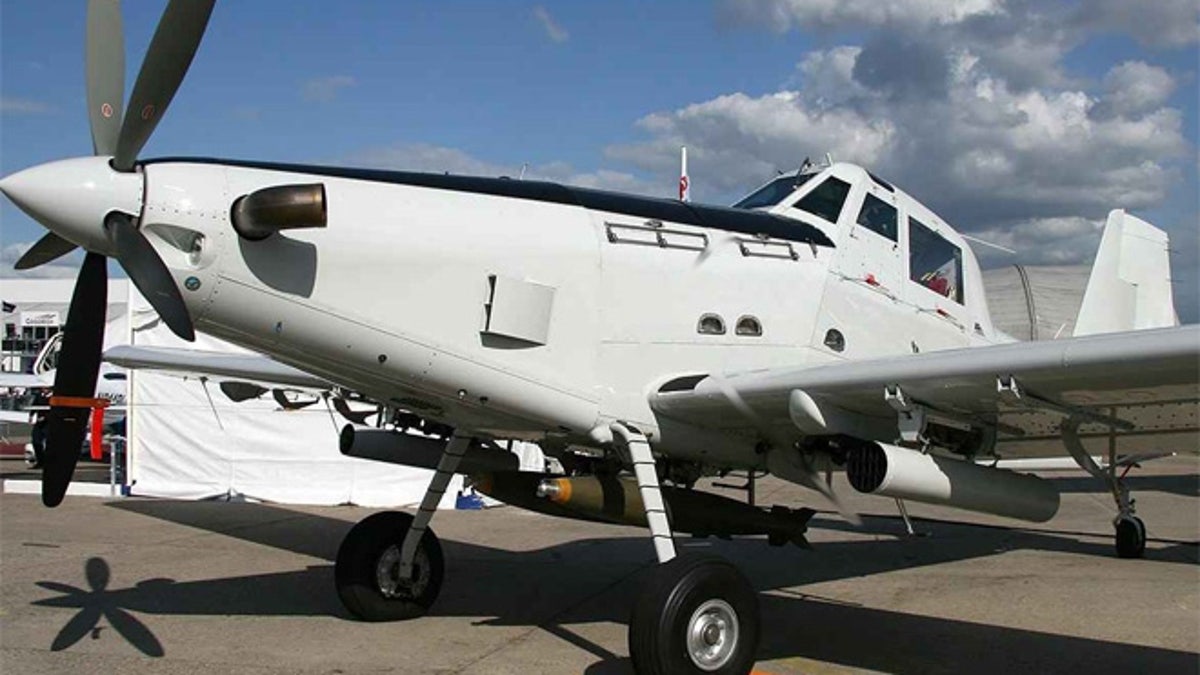
The U.S. changed plans and is giving the Jordanian military upgraded AF-802s to use in its fight against terrorism. (US Defense Department/ War Is Boring)
They may look like your average crop dusters, but four U.S. planes being sent to Jordan are outfitted with state-of-the-art surveillance gear and laser weapons that will allow the Middle Eastern ally to patrol its lawless eastern border with Iraq, where the ISIS threat looms large.
The spy planes, retrofitted 36-foot AT-802 two-seaters, were initially destined for Yemen, where the U.S. had been trying to help the president hold off an Iranian-backed siege. But with American forces pulled out of that Gulf nation, and Jordan in need of help in the fight against ISIS, the new planes could be the first installment of a bigger armament package diverted from Yemen. The Air Force ordered accelerated delivery of the planes, which Amman requested to help it seek and destroy terror threats on both sides of the border, and documents seemed to indicate that personnel could be on the way, too.
"These four aircraft are urgently needed to eliminate a combat capability deficiency, which is likely to result in combat fatalities"
"These four aircraft are urgently needed to eliminate a combat capability deficiency, which is likely to result in combat fatalities," the military order said. "The Kingdom of Jordan faces a myriad of nationwide threats requiring specially trained United States Central Command forces to assist conducting Counter Terrorism missions."
The document cites "increasingly high volume of insurgent activity" in the country. The U.S. has already supplied Jordan with JDAM precision bombs for its air campaign against ISIS in Syria and Iraq, and has long provided F-16s to the monarchy. Last summer, Israel gave 16 Bell Cobra attack helicopters to Jordan's Royal Air Force, which is small but capable, and includes 16 squadrons. The Arab nation began air strikes on ISIS late last year, and King Abdullah II, himself a fighter pilot and special forces operator, angrily accelerated strikes after a Jordanian pilot crashed, was captured and then burned alive on a video ISIS posted online.
Abdullah vowed that retaliation "will be harsh because this terrorist organization is not only fighting us, but also fighting Islam and its pure values."
Air Tractor, a U.S.-based company, manufactures the distinctive spy aircraft. The planes are called "green" in aviation parlance, meaning they can easily be equipped with armor, cameras and weapons. L-3 Communications, the Texas-based company that contracts with the Pentagon to modify the planes, referred FoxNews.com to the Air Force. The air force did not immediately respond to emails.
Chuck Miller, vice president of Air Tractor's business development, said the company produces between 190 to 200 planes a year. The company sees growth potential for a military role, since The AT-802 is used for surveillance in several countries in the Middle East and has been employed for decades to monitor drug smuggling in the forests of Colombia.
There is an obvious appeal for the planes that are manufactured in Olney, Texas. Their Pratt & Whitney Canada turbine engines allow the plane to travel at up to 200 mph. They are low-maintenance, do not require a runway to land, do not require a hangar and, after fueling, can return to the air in as little as five minutes, the company said in a statement.
Miller declined to discuss specific upgrades, but military website War Is Boring reported last year that the planes meant for Yemen would come with full-motion video cameras and communications gear. BuzzFeed reported at the time that those planes would be armed with laser-guided missiles and high-tech intelligence equipment. The idea is that the same planes used to track smuggling could track ISIS and other terror cells.
A few years back, the United Arab Emirates saw the appeal and ordered 24 aircraft from Air Tractor after State Department approval. In August, the company said the Israeli Ministry of Defense took a delivery of six more models to add to its fleet of 14.
U.S. officials did not comment on why the planes are no longer needed in Yemen, but Iranian-backed Shiite Houthi rebels and their allies captured the country's capital, Sana'a, in February. The Saudi allied government was essentially chased from power, which prompted air strikes by The Kingdom. The country has seen fighting between the Houthis, forces fighting for the former President Abed Rabbo Mansour Hadi and Sunni extremists.
In September, just one month before the Air Force announced the plans to send the planes to Jordan instead of Yemen, President Obama met with the new Saudi king, Salman bin Adbulaziz al-Saud, and talked about his “concerns” about Yemen and the need to restore a "functioning government."
BuzzFeed's report in March 2014 pointed out that, when pressed about the project, a Pentagon official said only, "The Department of Defense is reassessing the program at this time."
The office for the U.N. high commissioner for human rights said Tuesday that some 2,615 civilians have been killed in Yemen violence over the last six months. About two-thirds of those deaths were caused by air strikes, and the rest by Houthi rebels and their allies, an official said.

